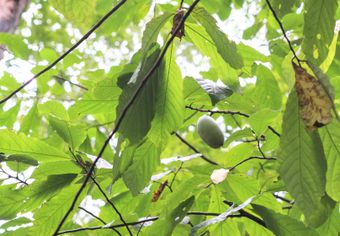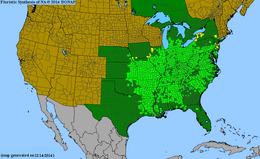Maryland DNR Recommended Tree and Deer-Resistant Plant
The pawpaw is a small, tropical-looking deciduous tree with large leaves. It grows to about 25' tall. It does best in consistently moist, well-drained, average soil in full sun to full shade. The fruit is a large, yellowish-green to brown berry containing large seeds and soft sweet fruit pulp that is custard-like in texture and somewhat similar in taste to banana, mango, and cantaloupe. Wild pawpaw fruits ripen in late August to mid-September, and when mature, the heavy fruits bend weak branches down. Fruit production normally begins when the tree reaches 6'. Fruiting best occurs in full sun. A long taproot keeps the pawpaw from transplanting easily. Keep the plants well watered. Two or more genetically different pawpaw trees are required for pollination.
The pawpaw is native to the eastern, southern, and Midwestern United States. The tree is commonly found in floodplains and shady, rich bottomlands. It tends to form patches of trees over time because of its shallow, horizontally spreading stems. The fruits are eaten by a variety of mammals, including raccoons, gray foxes, opossums, and squirrels. The tree's strong-smelling leaves and twigs–which contain natural insecticides–are seldom eaten by rabbits or deer or many insects. However, it is a host plant for the zebra swallowtail butterfly and various moth species that have evolved the ability to consume pawpaw leaves.
Pawpaw was Adkins Arboretum's Native Tree of the Year in 2020.
Photo by Kellen McCluskey
BONAP Native Range Map (bright green indicates county native, dark green indicates state native)


